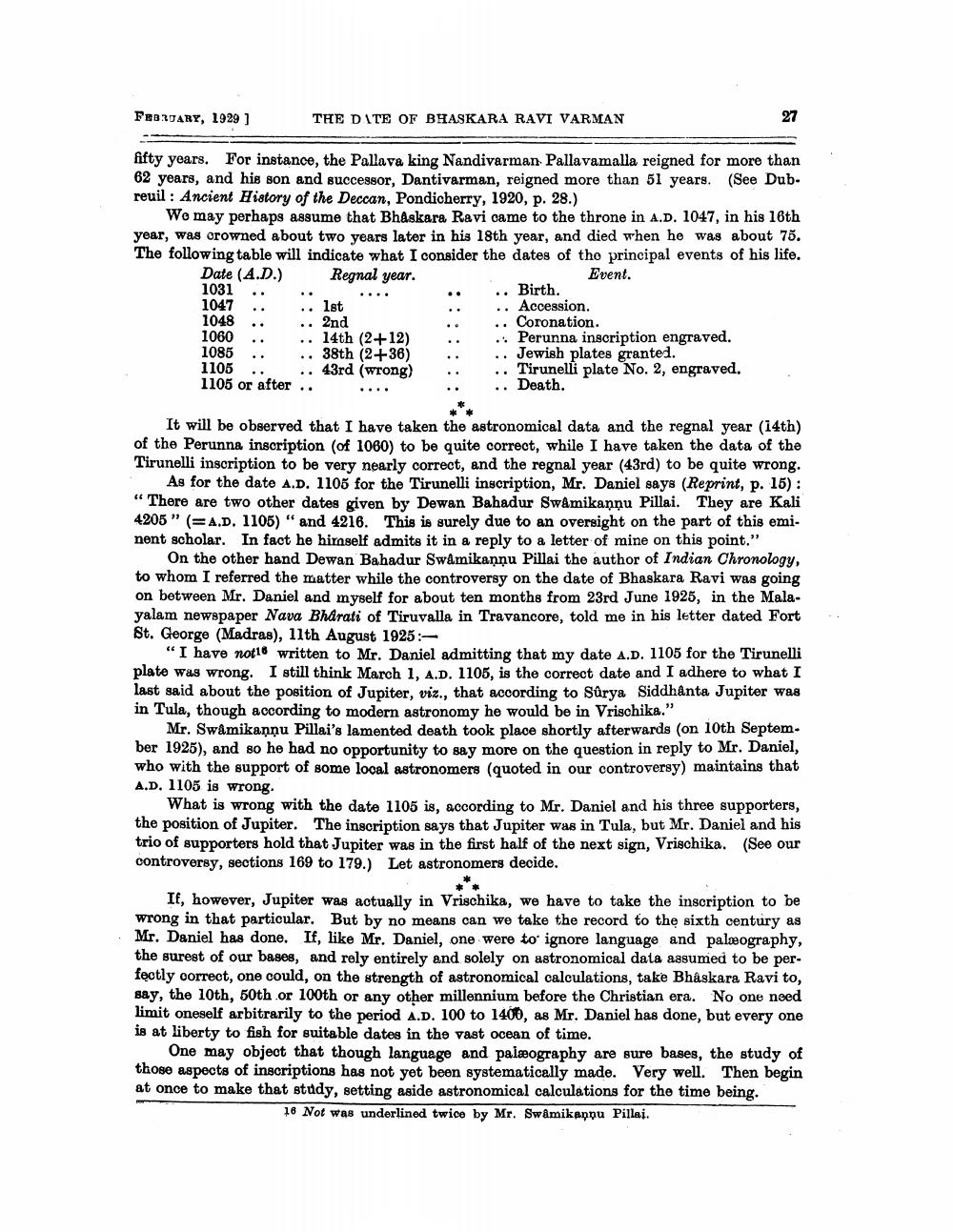________________
FEBRUARY, 1929 ]
THE DATE OF BHASKARA RAVI VARMAN
27
fifty years. For instance, the Pallava king Nandivarman Pallavamalla reigned for more than 62 years, and his son and successor, Dantivarman, reigned more than 51 years. (See Dub. reuil : Ancient History of the Deccan, Pondicherry, 1920, p. 28.)
We may perhaps assume that Bhaskara Ravi came to the throne in A.D. 1047, in his 16th year, was crowned about two years later in his 18th year, and died when he was about 75. The following table will indicate what I consider the dates of the principal events of his life. Date (A.D.) Regnal year.
Event. 1031 ..
Birth. 1047 ..
.. Accession. 1048
.. Coronation. 1060 . . . . 14th (2+12)
Perunna inscription engraved. 1085 .. .. 38th (2+36)
.. Jewish plates granted. 1105 . .. 43rd (wrong)
.. Tirunelli plate No. 2, engraved. 1105 or after ..
.. Death.
1st
.. 2nd
It will be observed that I have taken the astronomical data and the regnal year (14th) of the Perunna inscription (of 1060) to be quite correct, while I have taken the data of the Tirunelli inscription to be very nearly correct, and the regnal year (43rd) to be quite wrong.
As for the date A.D. 1105 for the Tirunelli inscription, Mr. Daniel says (Reprint, p. 15): “There are two other dates given by Dewan Bahadur Swamikannu Pillai. They are Kali 4205" (=A.D. 1105) " and 4216. This is surely due to an oversight on the part of this emi. nent scholar. In fact he hiroself admits it in a reply to a letter of mine on this point."
On the other hand Dewan Bahadur Swamikannu Pillai the author of Indian Chronology, to whom I referred the matter while the controversy on the date of Bhaskara Ravi was going on between Mr. Daniel and myself for about ten months from 23rd June 1925, in the Malayalam newspaper Nava Bharati of Tiruvalla in Travancore, told me in his letter dated Fort St. George (Madras), 11th August 1925:
"I have not16 written to Mr. Daniel admitting that my date A.D. 1105 for the Tirunelli plate was wrong. I still think March 1, A.D. 1105, is the correct date and I adhere to what I last said about the position of Jupiter, viz., that according to Surya Siddhanta Jupiter was in Tula, though according to modern astronomy he would be in Vrischika."
Mr. Swamikaņņu Pillai's lamented death took place shortly afterwards (on 10th September 1925), and so he had no opportunity to say more on the question in reply to Mr. Daniel, who with the support of some local astronomers (quoted in our controversy) maintains that A.D. 1105 is wrong.
What is wrong with the date 1105 is, according to Mr. Daniel and his three supporters, the position of Jupiter. The inscription says that Jupiter was in Tula, but Mr. Daniel and his trio of supporters hold that Jupiter was in the first half of the next sign, Vrischika. (See our controversy, sections 169 to 179.) Let astronomers decide.
If, however, Jupiter was actually in Vrischika, we have to take the inscription to be wrong in that particular. But by no means can we take the record to the sixth century as Mr. Daniel has done. If, like Mr. Daniel, one were to ignore language and paleography, the surest of our bases, and rely entirely and solely on astronomical data assumed to be perfectly correct, one could, on the strength of astronomical calculations, take Bhaskara Ravi to, say, the 10th, 50th or 100th or any other millennium before the Christian era. No one need limit oneself arbitrarily to the period A.D. 100 to 1400, as Mr. Daniel has done, but every one is at liberty to fish for suitable dates in the vast ocean of time.
One may object that though language and palæography are sure bases, the study of those aspects of inscriptions has not yet been systematically made. Very well. Then begin at once to make that study, setting aside astronomical calculations for the time being.
18 Not was underlined twice by Mr. Swamikannu Pillai.




